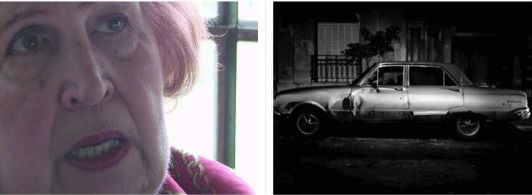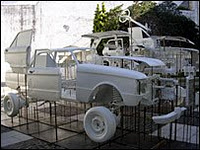“It was a death-mobile, the embodiment of terror. Whenever a Falcon drove by we knew there would be kidnappings, disappearance, torture, murder.”
Eduardo Pavlovsky
The Ford Falcon design team was led by Robert McNamara who wanted a new Model-T — a car that was inexpensive and reliable. In 1960, before he left for the Kennedy White House, McNamara saw his car in production. Two of the new cars were shipped to Argentina in 1961 as exemplars for local manufacture.
A new middle class was forming in Argentina, people with reasonably good jobs who could afford a new car. The Ford plant at La Boca began turning out Falcons in 1962. This was a popular car, a reliable, affordable vehicle that was much appreciated by Argentineans. Alejandro Hernandez, member of the Friends of the Falcon Club: “In Argentina we have classics like the tango, mate (tea), soccer and the Falcon. It’s a national lifestyle. It’s as Argentine as the gaucho… I was born at home and my father always had a Falcon, he took it to work and it went through the mud taking the whole family out to the countryside.”
By 1973, the Argentinean Falcon was almost entirely made in that country, only 26 of more than 3000 parts had to be imported, and the car had undergone several design makeovers, distinguishing it from the US model. It is the best-selling car in Argentina’s history. But internal tensions were building in Argentina and, in 1976, military forces seized power.
“It’s not the Falcon’s fault. The police probably just needed a car that didn’t break down, so they got Falcons,” says Alejandro Hernandez. The regular police got Falcons painted in regular police black and white, but the secret police and the paramilitary organizations tended to prefer dark green vehicles. Soon, the sight of a green falcon was enough to frighten every Argentinean who saw it.
The paramilitary units had been operating for several years before the 1976 coup. They kidnapped, tortured, and murdered labor leaders, journalists, and anyone else deemed a subversive. Most active opposition to the junta was murdered at the beginning of the coup, then the police went after anyone they wished. Thirty thousand people simply disappeared during the period of The Dirty War, 1976 -1983.
In 1976, a group of high school students protested high bus fares and the secret police disappeared them. One of these children was the sixteen-year-old daughter of state senator Mendes de Falcone (yes) and his wife Nelva. Their son went into hiding and the parents took him food and supplies when they could in their (yes) green falcon. One night they were stopped by the secret police and driven away in an official green falcon. Nelva was tortured with a cattle prod and her husband forced to watch. A month later, they were released but the senator died soon after of a heart attack. Their green Falcon was located and Nelva drove it home. Then she banded with others who had loved ones among the disappeared. Soon they organized the Mothers of Plaza de Mayo, an organization that demonstrated and demanded answers from the Argentine government for years even as some of its members were themselves disappeared. Nelva’s daughter has never been accounted for.
One of the government’s first targets was the Ford plant itself. The auto-workers union, SMATA, was largely compliant with official demands, but a growing contingent of young workers wanted something more than wage-slavery to an oppressive regime; they became increasingly important and began to show some real power. In 1976, the Ford workers had just won a new contract that emphasized safety issues and working conditions. The morning that the new contract was to take effect, workers, especially union delegates, began disappearing.
Actually troops had been patrolling the Ford factory for a year, invited in by the company under the pretext of defending against violent Marxists. The relationship between the Army and corporations was already developed before the coup. Now the workplace became a place of terror. One worker was told by his foreman that he would be taken away that day. “Don’t leave your place on the line,” he was told, “they’re watching.” Twenty-five workers were taken away from the plant; their wives were given pink slips saying that their husbands were fired for failure to report for work even though most of them had been abducted from the factory.
Fifteen of the many disappeared workers survived and they have undertaken a lawsuit against the Ford Motor Company (others are suing Chrysler-Daimler for more or less the same crimes). They say the company was complicit in the kidnappings, torture, and murder. Ford says that this was all the work of government forces and that such crimes are strictly against company policy.
After the junta’s collapse, Argentina officially adopted a policy of forgive-and-forget. The Mothers of the Plaza Mayo refused to do either and the official policy has lost its force. So far there have been a few trials and convictions of junta members for their crimes. Attempts have been made to bring criminal charges against Ford.
Meanwhile, the Falcon is still a well-known Argentine car. Some refuse to have anything to do with the vehicle; the very sight of a Falcon, especially a green Falcon, upsets them:
But at least one Falcon owner has added a sign in his car’s window: “My car is not to blame” and nunca mas, “Never Again”, the current slogan of those trying to put Argentina back together.
Then there is this: After Argentina’s 2001 debt crisis, a number of worker-controlled factories and workshops were set up by people unwilling to go under with the wealthy elites that had bankrupted the country. Ever since, the usual suspects have been trying to shut these enterprises down. In 2005, somebody abducted the wife of a Ceramica Zanon employee — Zanon being one of the most successful of the worker-run factories. The woman was tortured and mutilated and given a warning that Zanon’s union would “run red with blood”, then she was driven away and dumped by the road. The car that was used was (yes) a green Falcon.
Much of this article comes from a feature documentary, Falcon: Can A Car be Guilty of Murder? So far as I know, it is not in general release.
Information about the Ford plant and the government comes from “The Falcon Remembered”, a NACLA Report on the Americas paper.




I heard this story a couple of years ago when I was in Buenos Aires. I also saw a few of the old Falcons on the streets.
I first heard about this on an episode of Art of the Heist (which will probably be a future subject for the Shrine). I was surprised that people had so demonized this vehicle but they were quite clear on the fact that the Falcon was connected to Evil.
[…] that they were willing to peddle national pride to any buyer. Some had reported seeing a green Ford Falcon death car – the favored vehicle of the secret police – parked outside the museum that […]
From what I’ve been reading, this might be a good choice for the new Pope-mobile!
[…] especially one painted dark green, stirs those memories and causes the pain to begin again. It is a horrible legacy for what everyone agrees was an otherwise fine […]
[…] очень сильно. Под фонарем стоит это — легендарный зеленый Форд Фалькон, машина, на которой ездила тайная полиция времен […]
Still like Falcon Futura Sprint wish they still made em cooler than Mustangs of same era my phone # [redacted — not a good idea to put out phone numbers. People wanting to sell a Falcon can contact Warren via eMail]
Hi Mike – I’m wondering if you know of a way that I could access the documentary that you mention here? I’m a doctoral candidate in history and it may be relevant to my research. Thank you!
No. It was on the InterNet but I don’t recall exactly where. I think the link was in a piece on the Falcon as artwork. Almost all the links I used are now dead.